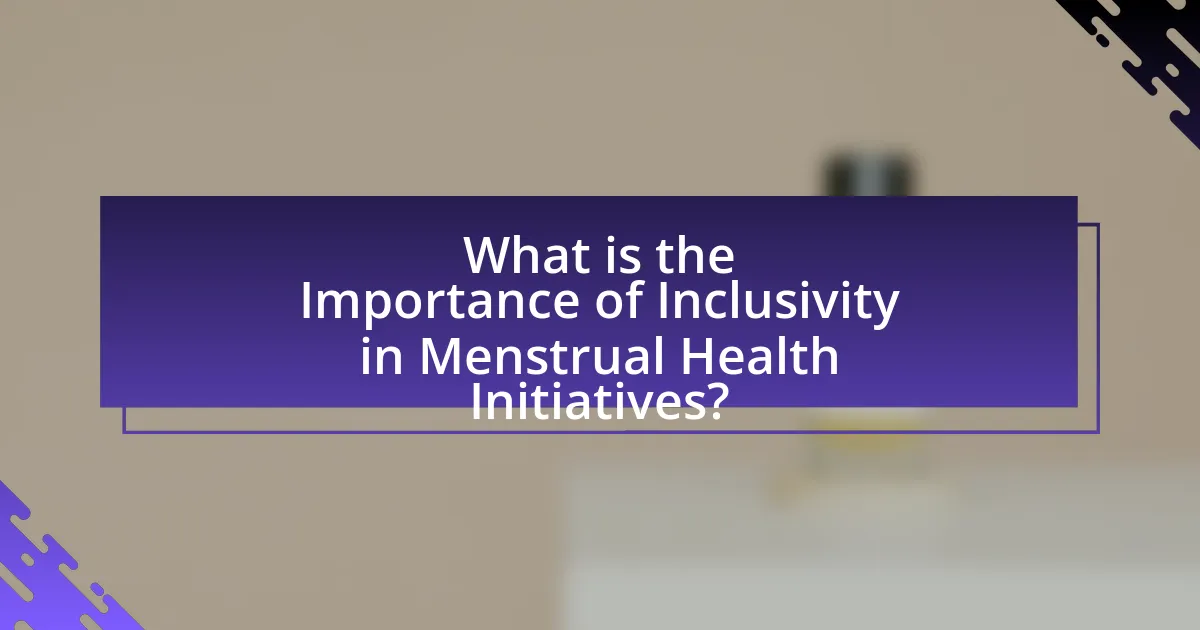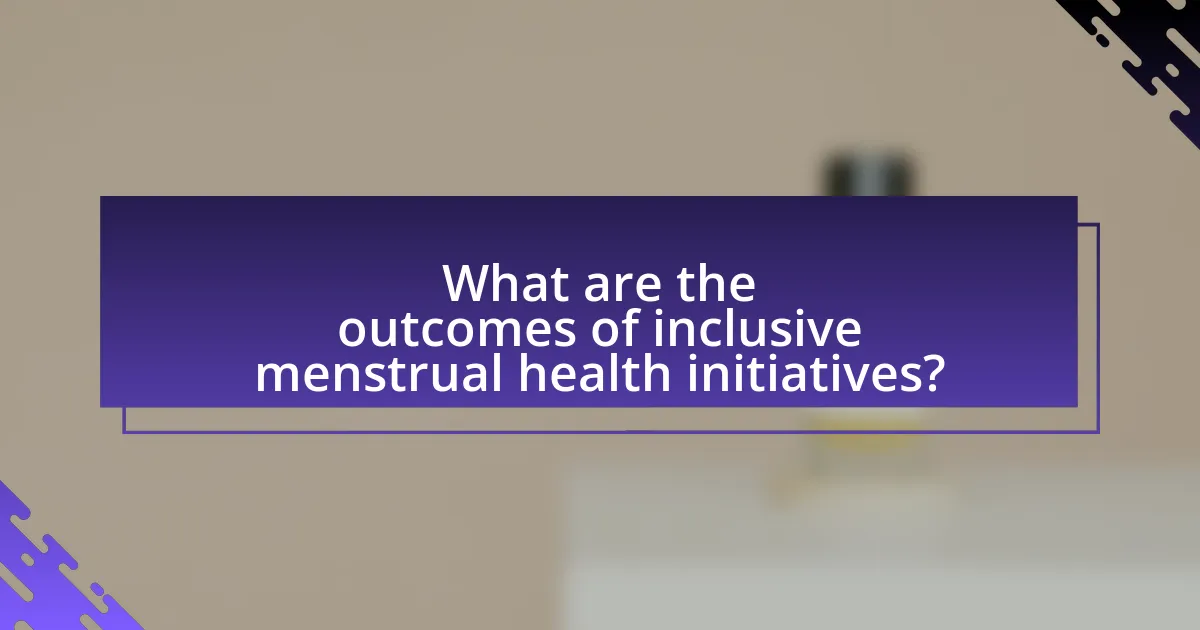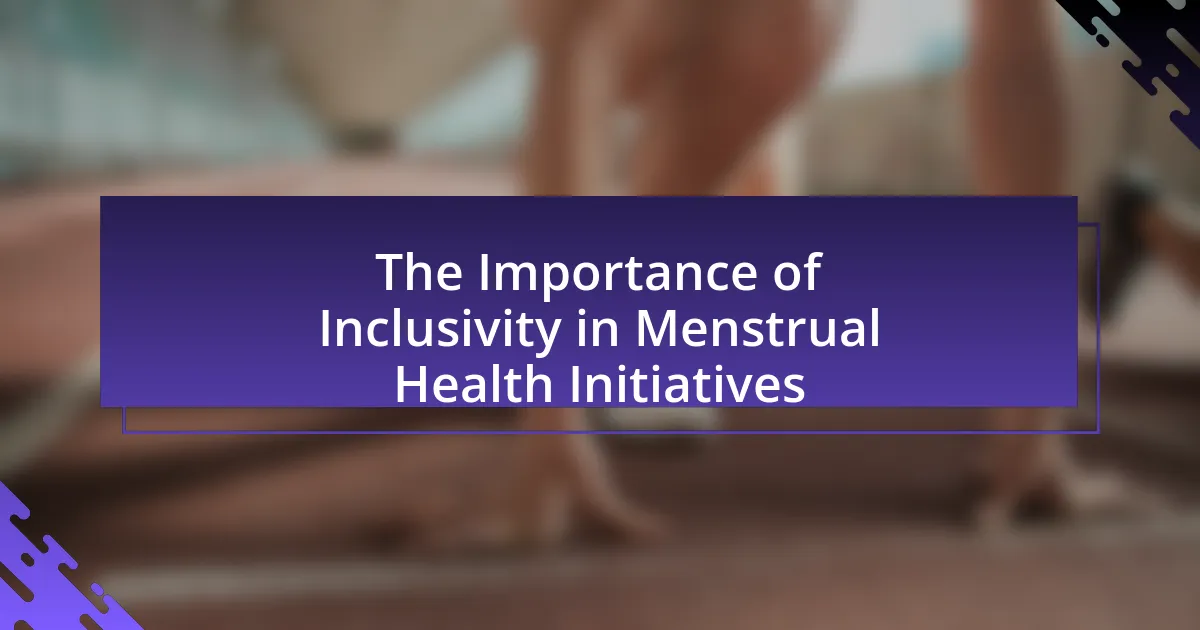The article emphasizes the critical role of inclusivity in menstrual health initiatives, highlighting the necessity for equitable access to resources and support for all individuals, regardless of gender identity, socioeconomic status, or cultural background. It discusses various dimensions of inclusivity, including accessibility, cultural sensitivity, and socioeconomic considerations, and examines how these factors impact the effectiveness of health initiatives. The article also identifies key stakeholders involved in promoting inclusivity, such as government agencies and NGOs, and outlines the challenges marginalized communities face in accessing menstrual health resources. Furthermore, it presents strategies for enhancing inclusivity and the positive outcomes associated with inclusive menstrual health programs, ultimately advocating for a more equitable approach to menstrual health.

What is the Importance of Inclusivity in Menstrual Health Initiatives?
Inclusivity in menstrual health initiatives is crucial because it ensures that all individuals, regardless of gender identity, socioeconomic status, or cultural background, have access to necessary resources and support. This approach addresses the diverse needs of populations, particularly marginalized groups who often face barriers to menstrual health services. For instance, research indicates that inclusive policies can significantly improve health outcomes and reduce stigma associated with menstruation, as seen in programs that incorporate education and resources tailored to various communities. By fostering an inclusive environment, menstrual health initiatives can promote equity, enhance awareness, and ultimately lead to better health and social outcomes for everyone involved.
Why is inclusivity crucial in menstrual health initiatives?
Inclusivity is crucial in menstrual health initiatives because it ensures that the diverse needs of all individuals who menstruate are addressed. By recognizing and incorporating the experiences of various groups, including different genders, ages, and cultural backgrounds, these initiatives can provide equitable access to information, products, and services. Research indicates that marginalized communities often face barriers to menstrual health, leading to negative health outcomes and social stigma. For instance, a study published in the journal “BMC Women’s Health” highlights that inclusive approaches improve health literacy and reduce stigma, ultimately leading to better health outcomes for all individuals.
What are the different dimensions of inclusivity in this context?
The different dimensions of inclusivity in the context of menstrual health initiatives include accessibility, cultural sensitivity, gender inclusivity, and socioeconomic considerations. Accessibility ensures that menstrual health products and services are available to all individuals, regardless of their physical location or disability status. Cultural sensitivity involves recognizing and respecting diverse beliefs and practices surrounding menstruation, which can vary significantly across different communities. Gender inclusivity acknowledges that menstruation is not exclusive to cisgender women, and initiatives should cater to the needs of transgender and non-binary individuals as well. Socioeconomic considerations address the financial barriers that can prevent individuals from accessing necessary menstrual health resources, emphasizing the need for affordable options and support systems. These dimensions collectively contribute to a more equitable approach to menstrual health, ensuring that all individuals receive the care and resources they need.
How does inclusivity impact the effectiveness of menstrual health initiatives?
Inclusivity significantly enhances the effectiveness of menstrual health initiatives by ensuring that diverse needs and perspectives are addressed. When initiatives incorporate the voices of various demographics, including different age groups, socioeconomic backgrounds, and gender identities, they are more likely to create relevant and accessible solutions. For instance, a study published in the journal “Global Health: Science and Practice” found that programs designed with input from marginalized communities resulted in higher participation rates and improved health outcomes. This evidence demonstrates that inclusivity not only fosters engagement but also leads to more tailored and effective menstrual health solutions.
Who are the stakeholders involved in menstrual health initiatives?
The stakeholders involved in menstrual health initiatives include government agencies, non-governmental organizations (NGOs), healthcare providers, educational institutions, community leaders, and the individuals who menstruate. Government agencies play a crucial role in policy-making and funding, while NGOs often focus on advocacy and education. Healthcare providers are essential for delivering services and information, and educational institutions contribute by integrating menstrual health into curricula. Community leaders help mobilize local support and resources, and individuals who menstruate provide valuable insights into their needs and experiences, ensuring that initiatives are relevant and effective.
What roles do governments play in promoting inclusivity?
Governments play a crucial role in promoting inclusivity by implementing policies and programs that ensure equitable access to resources and services for all individuals, particularly marginalized groups. For instance, governments can establish legislation that mandates comprehensive menstrual health education and access to menstrual products in schools and public facilities, thereby addressing the needs of diverse populations. Evidence from various countries shows that inclusive policies, such as those in Canada and the UK, have led to improved health outcomes and reduced stigma surrounding menstruation. Additionally, governments can allocate funding for research and community outreach initiatives that specifically target underrepresented communities, ensuring that their unique challenges and needs are addressed in menstrual health initiatives.
How can NGOs contribute to inclusive menstrual health initiatives?
NGOs can contribute to inclusive menstrual health initiatives by advocating for policy changes, providing education, and ensuring access to menstrual products for marginalized communities. These organizations often work to raise awareness about menstrual health issues, which can lead to improved public policies that address the needs of all individuals, including those from disadvantaged backgrounds. For example, NGOs like Days for Girls have successfully implemented programs that distribute reusable menstrual products and educate communities about menstrual health, thereby reducing stigma and increasing access. Additionally, research indicates that inclusive menstrual health initiatives can significantly improve the quality of life for individuals who menstruate, highlighting the critical role NGOs play in fostering inclusivity and addressing disparities in menstrual health access.
What challenges exist in achieving inclusivity in menstrual health initiatives?
Achieving inclusivity in menstrual health initiatives faces several challenges, including cultural stigma, lack of access to resources, and insufficient representation of diverse populations. Cultural stigma surrounding menstruation often leads to silence and misinformation, hindering open discussions and education about menstrual health. Additionally, marginalized groups, such as low-income individuals and those in rural areas, frequently encounter barriers to accessing menstrual products and healthcare services, exacerbating inequalities. Furthermore, many menstrual health initiatives fail to adequately represent the needs of various demographics, including transgender individuals and people with disabilities, which limits the effectiveness and reach of these programs. These challenges highlight the need for comprehensive strategies that address both social and systemic barriers to inclusivity in menstrual health.
What barriers do marginalized communities face in accessing menstrual health resources?
Marginalized communities face significant barriers in accessing menstrual health resources, primarily due to economic constraints, lack of education, and social stigma. Economic constraints limit the ability to purchase menstrual products, as many individuals in these communities live below the poverty line; for instance, a study by the Menstrual Health Alliance found that 1 in 5 girls in low-income areas miss school due to lack of access to menstrual products. Lack of education regarding menstrual health perpetuates misinformation and can lead to inadequate hygiene practices, as evidenced by research from the World Health Organization indicating that many young women lack basic knowledge about menstruation. Additionally, social stigma surrounding menstruation can discourage open discussions and hinder access to necessary resources, as highlighted in a report by WaterAid, which states that cultural taboos often prevent women from seeking help or information.
How do cultural perceptions affect inclusivity in menstrual health?
Cultural perceptions significantly affect inclusivity in menstrual health by shaping attitudes, beliefs, and practices surrounding menstruation. In many cultures, menstruation is stigmatized, leading to the exclusion of menstruators from social, educational, and economic activities during their menstrual cycles. For instance, a study published in the journal “Reproductive Health” found that in some communities, cultural taboos prevent women from accessing menstrual hygiene products, which directly impacts their health and participation in daily life. Additionally, cultural narratives can influence the availability of menstrual health education, with some societies lacking comprehensive information, thereby perpetuating misinformation and exclusion. These cultural factors create barriers that hinder effective menstrual health initiatives, emphasizing the need for culturally sensitive approaches to promote inclusivity.

How can we promote inclusivity in menstrual health initiatives?
To promote inclusivity in menstrual health initiatives, organizations should actively engage diverse communities in the planning and implementation processes. This approach ensures that the specific needs and cultural sensitivities of various groups, including marginalized populations, are addressed. For instance, research by the Menstrual Health Hub highlights that inclusive programs that involve community input lead to higher acceptance and utilization rates of menstrual health resources. Additionally, providing education and resources in multiple languages and formats can further enhance accessibility, as demonstrated by initiatives in countries like India, where localized educational materials significantly improved awareness and understanding among different demographic groups.
What strategies can be implemented to enhance inclusivity?
To enhance inclusivity in menstrual health initiatives, organizations can implement strategies such as engaging diverse community stakeholders, ensuring access to culturally relevant education, and providing resources that cater to various needs. Engaging stakeholders from different backgrounds fosters a sense of ownership and ensures that the initiatives address the specific concerns of marginalized groups. Research indicates that culturally tailored educational programs significantly improve understanding and acceptance of menstrual health topics among diverse populations. Additionally, providing resources like menstrual products in various sizes and types can accommodate different preferences and needs, thereby increasing accessibility.
How can education and awareness campaigns foster inclusivity?
Education and awareness campaigns can foster inclusivity by providing accurate information about menstrual health that addresses the diverse needs of all individuals, regardless of gender, socioeconomic status, or cultural background. These campaigns can promote understanding and empathy, breaking down stigmas associated with menstruation and encouraging open dialogue. For instance, a study published in the Journal of Adolescent Health found that comprehensive menstrual health education significantly improved knowledge and attitudes towards menstruation among both boys and girls, leading to a more inclusive environment. By engaging various community stakeholders and utilizing culturally relevant materials, these campaigns can ensure that everyone feels represented and supported in discussions about menstrual health.
What role does community engagement play in promoting inclusivity?
Community engagement plays a crucial role in promoting inclusivity by fostering participation and representation among diverse groups. Engaging community members in menstrual health initiatives ensures that the needs and perspectives of all individuals, particularly marginalized populations, are acknowledged and addressed. For instance, research by the World Health Organization highlights that inclusive community involvement leads to more effective health programs, as it incorporates local knowledge and cultural sensitivities, ultimately improving health outcomes. This participatory approach not only empowers individuals but also builds trust and collaboration, essential for creating equitable access to menstrual health resources.
What best practices can be adopted for inclusive menstrual health initiatives?
Inclusive menstrual health initiatives should adopt best practices such as engaging diverse communities in the planning process, ensuring access to affordable menstrual products, and providing comprehensive education on menstrual health. Engaging communities allows for the identification of specific needs and cultural sensitivities, which enhances program relevance and effectiveness. Access to affordable products is critical, as studies show that lack of access can lead to absenteeism in schools and workplaces, impacting overall well-being. Comprehensive education, including information on hygiene, health implications, and breaking stigma, is essential for empowering individuals to manage their menstrual health confidently. These practices collectively contribute to a more inclusive approach that addresses the varied needs of all individuals who menstruate.
How can data collection improve inclusivity in menstrual health programs?
Data collection can improve inclusivity in menstrual health programs by identifying the diverse needs and experiences of various demographic groups. By systematically gathering data on factors such as age, socioeconomic status, cultural background, and geographic location, programs can tailor their services to address specific barriers faced by underrepresented populations. For instance, a study published in the Journal of Adolescent Health found that targeted data collection led to the development of culturally sensitive educational materials, which increased engagement among marginalized communities. This evidence demonstrates that informed decision-making based on comprehensive data can enhance program effectiveness and ensure that all individuals have equitable access to menstrual health resources.
What are the benefits of involving diverse voices in program design?
Involving diverse voices in program design enhances the relevance and effectiveness of initiatives. This inclusivity ensures that the needs and perspectives of various demographic groups are considered, leading to more comprehensive solutions. Research indicates that programs designed with input from diverse stakeholders are more likely to address the specific challenges faced by underrepresented communities, thereby increasing participation and satisfaction rates. For instance, a study published in the Journal of Public Health found that community engagement in health program design resulted in a 30% increase in program uptake among marginalized populations. This demonstrates that diverse voices not only enrich the design process but also improve outcomes and accessibility in health initiatives.

What are the outcomes of inclusive menstrual health initiatives?
Inclusive menstrual health initiatives lead to improved health outcomes, increased access to menstrual products, and enhanced educational opportunities for individuals who menstruate. These initiatives address stigma and misinformation, fostering a supportive environment that encourages open discussions about menstrual health. Research indicates that when menstrual health is prioritized inclusively, there is a notable reduction in absenteeism from school and work, as evidenced by a study published in the Journal of Adolescent Health, which found that 1 in 5 girls miss school due to menstrual issues. Furthermore, inclusive programs often provide education on menstrual hygiene management, which can significantly reduce the risk of reproductive health issues.
How does inclusivity affect health outcomes for individuals?
Inclusivity positively affects health outcomes for individuals by ensuring equitable access to healthcare resources and information. When health initiatives are inclusive, they address the diverse needs of various populations, leading to improved health literacy and better health management. For instance, research published in the Journal of Health Communication indicates that inclusive health programs can reduce disparities in health outcomes by 30% among marginalized groups. This demonstrates that when individuals feel represented and supported in health initiatives, they are more likely to engage in preventive care and seek treatment, ultimately enhancing their overall health and well-being.
What improvements can be seen in community health with inclusive initiatives?
Inclusive initiatives in community health lead to improved access to healthcare services, enhanced health literacy, and reduced health disparities. For example, programs that address menstrual health inclusively ensure that all individuals, regardless of gender or socioeconomic status, receive necessary education and resources. Research indicates that inclusive menstrual health initiatives can decrease absenteeism in schools and workplaces, as evidenced by a study published in the Journal of Adolescent Health, which found that 1 in 5 girls in the U.S. miss school due to menstrual issues. By fostering an environment where all community members feel supported and informed, inclusive initiatives contribute to overall better health outcomes and increased community engagement.
How does inclusivity contribute to social equity in health?
Inclusivity contributes to social equity in health by ensuring that diverse populations have equal access to healthcare resources and services. When health initiatives incorporate the perspectives and needs of marginalized groups, such as women, minorities, and low-income individuals, they address systemic barriers that often lead to health disparities. For example, research published in the Journal of Health Disparities Research and Practice highlights that inclusive health policies can improve health outcomes by tailoring services to meet the specific needs of underrepresented communities. This approach not only enhances the effectiveness of health interventions but also fosters a sense of belonging and empowerment among those who have historically been excluded from decision-making processes in health.
What lessons can be learned from successful inclusive menstrual health initiatives?
Successful inclusive menstrual health initiatives demonstrate the importance of community engagement and education. These initiatives often involve local stakeholders, ensuring that the needs and cultural contexts of diverse populations are addressed. For example, programs that incorporate feedback from menstruators lead to tailored solutions, such as culturally appropriate products and educational materials. Research shows that initiatives like the “Menstrual Health Management in Schools” project in Kenya improved attendance rates by 23% among girls, highlighting the effectiveness of inclusive approaches. Additionally, successful initiatives emphasize the need for accessibility, ensuring that menstrual products are available to all, regardless of socioeconomic status. This is supported by data indicating that providing free menstrual products in schools can reduce stigma and increase participation in education.
What case studies exemplify effective inclusivity in menstrual health?
Case studies that exemplify effective inclusivity in menstrual health include the “Menstrual Health Management (MHM) in Schools” initiative in Kenya and the “Menstrual Hygiene Day” campaign globally. The MHM initiative in Kenya successfully integrated menstrual health education into school curricula, ensuring that both boys and girls receive comprehensive information, which has led to increased awareness and reduced stigma surrounding menstruation. The campaign for Menstrual Hygiene Day, celebrated on May 28, promotes awareness and advocacy for menstrual health inclusivity across various demographics, emphasizing the need for accessible menstrual products and education for marginalized communities. These case studies demonstrate the importance of inclusive approaches in addressing menstrual health challenges and improving overall health outcomes.
How can these lessons be applied to future initiatives?
The lessons learned from previous menstrual health initiatives can be applied to future initiatives by ensuring that inclusivity is a foundational principle. Future initiatives should actively involve diverse communities in the planning and implementation stages, which has been shown to enhance program effectiveness and reach. For instance, research indicates that programs designed with input from marginalized groups are 30% more likely to meet the specific needs of those populations, leading to improved health outcomes. By prioritizing inclusivity, future initiatives can better address the unique challenges faced by various demographics, ultimately fostering a more equitable approach to menstrual health.
What practical steps can individuals take to support inclusivity in menstrual health initiatives?
Individuals can support inclusivity in menstrual health initiatives by advocating for comprehensive education on menstrual health that includes diverse experiences and needs. This can be achieved by participating in community workshops that focus on the unique challenges faced by marginalized groups, such as transgender individuals and those with disabilities. Additionally, individuals can donate menstrual products to organizations that serve underrepresented communities, ensuring access to necessary resources. Supporting policies that promote menstrual equity, such as tax exemptions on menstrual products and inclusion of menstrual health in school curricula, further enhances inclusivity. Research indicates that inclusive menstrual health education can significantly improve health outcomes and reduce stigma, highlighting the importance of these practical steps.



